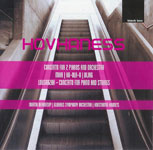Several familiar ingredients of Alan Hovhaness’ early style combine to make a dish of rather unusual flavor in his Concerto for two pianos and orchestra. There is rich brass writing, long modal melodies, false relationships in triadic chordal writing, and decorative notes alien to the underlying harmonies. The extra-tonal material most often is given to the duo-pianists–thus, their part occupies a contrasting world of thick, dissonant chords, sometimes sounding like Messiaen.
Written in the early 1950s, the Concerto was unheard for 50 years. Black Box’s notes say it was premiered in Russia in 2004, presumably by the same artists who produced this recording in 2003. Although the half-century between composition and posthumous first performance might suggest that Hovhaness was not fully committed to the music, soloists Martin Berofsky and Atakan Sari, with Konstantin Krimets conducting the Globalis Symphony Orchestra, obviously are. They play this solidly written music very well, although its appeal may not extend to fans of Hovhaness who respond mainly to the composer’s more familiar ecstatic sound.
The other large-scale work on the disc is Lousadzak, the 1944 composition Hovhaness credited with solidifying his style. Imitating instruments and sounds from the composer’s ancestral region of South-West Asia, it is an austere piano concerto with string orchestra. The murmuring effect of a family of instruments playing a given figuration, entirely asynchronously, makes its first appearance in a major Hovhaness composition here. Berofsky, Krimets, and the orchestra again are fully in touch with the music.
The remainder of the disc presents a set of three duo-piano works. Sari returns as second piano in the largest of the three pieces (Mihr, 1945), and he is replaced by Sergei Podobedov in the briefer To the Ko-ola-u Mountains (1962) and Vijag (1946). Vijag is an Armenian Ascension ceremony in which two melodies in different modes mix above a constant drone figuration. In Ko-ola-u the contrast is between densely urban Honolulu and the Ko’olau (“Windward”) Mountains, specifically pointing to the short-sighted tendency of humans to ignore the splendid natural backdrop in preference to the transient city.
The earlier pair of pieces has a sinewy sound similar to Lousadzak, while the Hawaiian evocation raises the charm quotient. Performances are crisp while slightly short on the element of fantasy. Sound is detailed and convincing if not highly alluring.
































